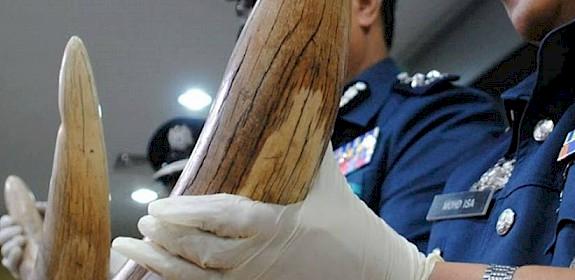Rhino poaching deaths continue to increase in South Africa
South Africa, 12th January 2012—Despite increased law enforcement efforts, rhino poaching accelerated in South Africa last year. The country lost 448 rhinos to poaching in 2011, official government statistics reveal. The total includes 19 critically endangered Black Rhinos, of which fewer than 5,000 remain in the wild.

In 2010, 333 South African rhinos were killed by poachers, nearly three times the number killed in 2009.
“The rate of poaching increase may appear to be faltering, but the bottom line is more rhinos than ever were poached in 2011,” said Dr Colman O Criodain, WWF’s wildlife trade policy analyst. “If left unchecked, poaching gangs could put the survival of these iconic species in jeopardy.”
More than half of South Africa’s rhino deaths occurred in world-famous Kruger National Park. The popular safari destination lost 252 rhinos in 2011, and witnessed the poaching of an additional eight rhinos in the first weeks of the New Year, according to authorities from South Africa National Parks.
South African law enforcement officials made 232 poaching-related arrests in 2011, compared to 165 the previous year. Sentences imposed for rhino crimes have also increased in recent years, with poachers and horn smugglers receiving as long as 16 years in prison.
“Rhino poaching is being conducted by sophisticated international criminal syndicates that smuggle horns to Asia,” said Dr Morné du Plessis, CEO of WWF-South Africa. “Its not enough to bust the little guy; investigators need to shut down the kingpins organizing these criminal operations. Governments in Africa and Asia must work together across borders to stop the illegal trade.”
The recent upsurge in rhino poaching has been tied to increased demand for rhino horn in Asia, particularly Vietnam, where it carries prestige as a luxury item, as a post-partying cleanser, and also as a purported cancer cure.
“Rhino horn has gained popularity among wealthy Vietnamese elites and business people to give as a gift, when currying political favour, or taking as an antidote to overindulgence,” said Tom Milliken, TRAFFIC’s rhino trade expert. “But killing endangered rhinos to mitigate a hangover is a criminal way to see in the New Year.”
According to Traditional Chinese Medicine experts, rhino horn has no proven cancer treating properties. Contrary to popular myth, it has never been used in traditional medicine as an aphrodisiac.
The Convention on International Trade in Endangered Species of Wild Fauna and Flora (CITES) has found that consumer demand in Vietnam is driving much of the rhino poaching. CITES has also ruled that Vietnam needs to show progress in curtailing illegal trade in rhino parts and derivatives.
“So far we have yet to see Vietnam respond to this ruling from CITES,” says O Criodain. “For that matter, CITES must put pressure on Vietnam to respond meaningfully, as it has done with other countries whose compliance with the Convention has been called into question.”
Because it is home to most of the world’s rhinos, South Africa has been the epicentre of poaching. However, rhinos in other African and Asian range countries are also being targeted by poachers.
In October, WWF announced the extinction of rhinos in Vietnam. The last Javan rhinoceros in the country was killed by poachers and its horn removed. In Nepal, however, strong conservation and law enforcement efforts ensured that no rhinos were lost to poaching in 2011.
In both Africa and Asia, WWF and TRAFFIC are providing assistance to field rangers, criminal investigators, prosecutors, and Customs authorities. Additionally, TRAFFIC has facilitated visits between South African and Vietnamese government officials to discuss deepening cooperation on law enforcement.
A bilateral treaty to ramp up law enforcement collaboration between South Africa and Vietnam was negotiated in September 2011 but still remains unsigned.
Notes:
Rhino population statistics
African species
Black Rhino: 4,838 IUCN Red List Classification: Critically Endangered
White Rhino: Approx 20,000, up from fewer than 100 in 1900. IUCN Red List Classification: Near Threatened
South Africa rhino population: 1,916 Black, 18,780 White
Asian species
Greater-one Horned: 2,913. IUCN Red List Classification: Vulnerable
Javan: No more than 50. IUCN Red List Classification: Critically endangered
Sumatran: Fewer than 200. IUCN Red List Classification: Critically endangered
South Africa poaching numbers
Source: SANParks
2009: 122 rhinos
2010: 333 rhinos
2011: 448 rhinos, 19 critically endangered Black.
Arrests in 2010: 165
Arrests in 2011: 232
About TRAFFIC

TRAFFIC is a leading non-governmental organisation working to ensure that trade in wild species is legal and sustainable, for the benefit of the planet and people.
WWF

WWF is an independent conservation organization, with over 30 million supporters and a global network active in over 100 countries. WWF's mission is to stop the degradation of the Earth's natural environment and to build a future in which humans live in harmony with nature, by conserving the world's biological diversity, ensuring that the use of renewable natural resources is sustainable, and promoting the reduction of pollution and wasteful consumption. Visit www.panda.org/news for the latest news and media resources and follow us on Twitter @WWF_media.




